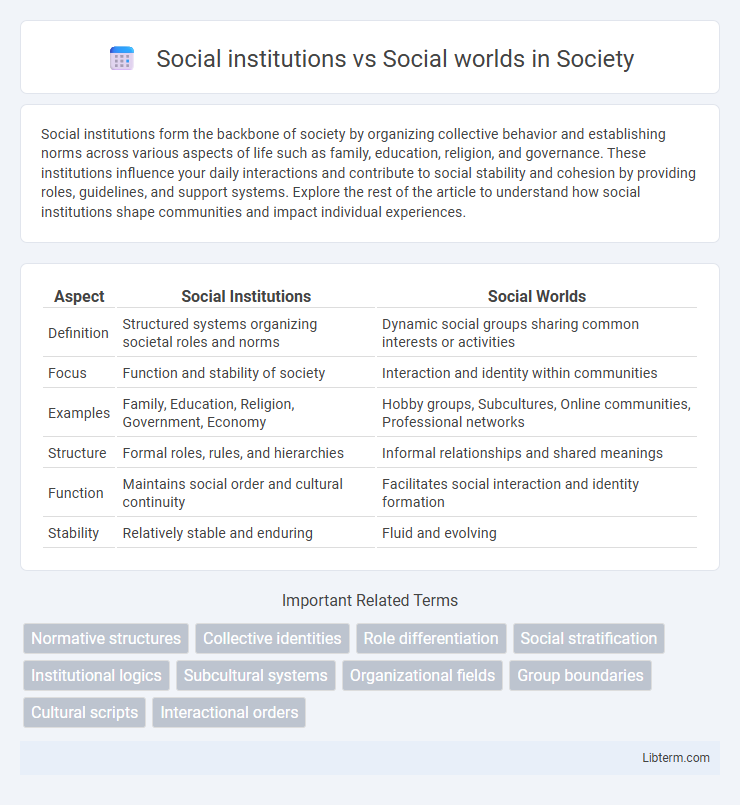Social institutions form the backbone of society by organizing collective behavior and establishing norms across various aspects of life such as family, education, religion, and governance. These institutions influence your daily interactions and contribute to social stability and cohesion by providing roles, guidelines, and support systems. Explore the rest of the article to understand how social institutions shape communities and impact individual experiences.
Table of Comparison
| Aspect | Social Institutions | Social Worlds |
|---|---|---|
| Definition | Structured systems organizing societal roles and norms | Dynamic social groups sharing common interests or activities |
| Focus | Function and stability of society | Interaction and identity within communities |
| Examples | Family, Education, Religion, Government, Economy | Hobby groups, Subcultures, Online communities, Professional networks |
| Structure | Formal roles, rules, and hierarchies | Informal relationships and shared meanings |
| Function | Maintains social order and cultural continuity | Facilitates social interaction and identity formation |
| Stability | Relatively stable and enduring | Fluid and evolving |
Defining Social Institutions and Social Worlds
Social institutions are structured systems and established norms that organize key societal functions such as family, education, and government, providing stability and patterned social order. Social worlds, in contrast, refer to the dynamic, localized contexts and shared meanings within which individuals interact, encompassing the cultural and social environments shaped by specific interests and practices. Understanding social institutions highlights formal rules and roles, while social worlds emphasize fluid social interactions and the creation of collective identities.
Historical Development of Social Institutions
Social institutions have evolved through historical processes to structure society by establishing stable patterns of behavior in areas such as family, education, and governance. These institutions are formalized systems embedded in culture and law, while social worlds represent dynamic networks of individuals sharing common interests and practices. The historical development of social institutions reflects shifts in economic, political, and technological contexts, shaping collective norms and societal organization over time.
The Concept of Social Worlds in Sociology
Social worlds in sociology refer to the distinct, interactive, and culturally shared spaces where individuals engage in common practices, forming fluid and overlapping networks distinct from formal social institutions. Unlike social institutions, which are structured systems organizing societal roles and norms (such as family, education, or government), social worlds emphasize dynamic, negotiated meanings and identities within specific contexts like subcultures or professional communities. This concept highlights how individuals co-construct realities through ongoing interactions, shaping social boundaries and collective experiences beyond institutional frameworks.
Key Differences Between Social Institutions and Social Worlds
Social institutions are organized structures with established norms and roles that govern behavior within society, such as family, education, or legal systems. Social worlds consist of smaller, more dynamic groups defined by shared activities, interests, or identities, like subcultures or professional communities. Key differences include the formal organization and regulatory functions of social institutions versus the fluid, interaction-based nature of social worlds.
Roles and Functions in Social Institutions
Social institutions structure societal roles and functions by establishing norms, rules, and expectations that guide individual behavior and maintain social order. Each role within an institution, such as family, education, or government, carries specific duties and responsibilities designed to fulfill essential societal functions like socialization, governance, or economic production. These roles contribute to the stability and continuity of social institutions, distinguishing them from social worlds, which are more fluid, experience-based communities shaped by shared activities and interactions rather than formalized roles or prescriptive functions.
Social Worlds: Dynamics and Boundaries
Social worlds consist of dynamic, interactive spaces where individuals share common interests, practices, and meanings, constantly evolving through social interactions and negotiations. Boundaries within social worlds are fluid and permeable, allowing for the inclusion or exclusion of members based on shifting norms, values, and identities. These boundaries facilitate the construction of social cohesion while enabling social worlds to adapt and transform in response to internal and external influences.
Interaction and Overlap: Institutions vs Worlds
Social institutions are structured systems with established norms and roles that govern interactions within society, while social worlds are fluid, overlapping spaces defined by shared activities and meanings. Interaction between these entities occurs as individuals navigate institutional expectations while participating in multiple social worlds, resulting in dynamic overlaps and transformations. This interplay highlights the complexity of social organization, where rigid institutional frameworks coexist with flexible, culturally rich social worlds.
Examples of Social Institutions and Social Worlds
Social institutions are structured systems like marriage, education, and religion that organize societal behavior and establish norms. Social worlds refer to smaller, more fluid communities such as gamer groups, academic circles, or online fan communities where individuals share common interests or activities. These examples highlight how social institutions regulate broad societal functions, while social worlds create spaces for shared identity and interaction within specific cultural or social contexts.
Impact on Individual and Collective Identity
Social institutions, such as family, education, and government, establish structured norms and roles that significantly shape individual and collective identities by providing a framework for behavior and societal expectations. Social worlds, including communities, subcultures, and online networks, offer dynamic and fluid environments where individuals negotiate and express identity through shared meanings and interactions. The interplay between social institutions and social worlds impacts identity formation by balancing stability and flexibility, influencing how individuals perceive themselves and their belonging within larger social groups.
Future Trends in Social Organization
Social institutions, such as governments, educational systems, and religious organizations, establish structured frameworks that govern societal behavior and norms, while social worlds encompass the dynamic, interactive spaces where individuals and groups create meaning and identity through shared experiences. Future trends in social organization emphasize increasing reliance on digital platforms and virtual communities, which blur traditional boundaries between institutions and social worlds, promoting decentralized and networked forms of social coordination. Advancements in artificial intelligence and blockchain technology are predicted to transform institutional transparency and participation, enabling more adaptive, inclusive, and responsive social structures.
Social institutions Infographic

 libterm.com
libterm.com